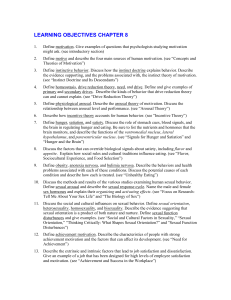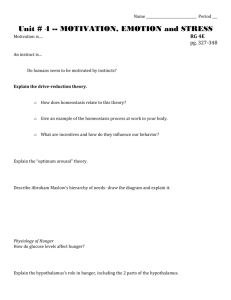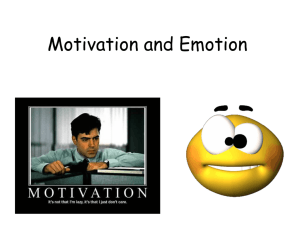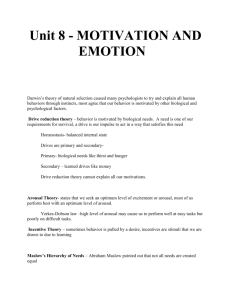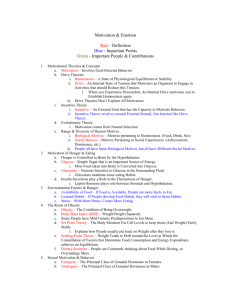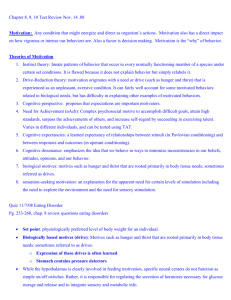Review * Chapter 12 & 13: Motivation & Work
advertisement
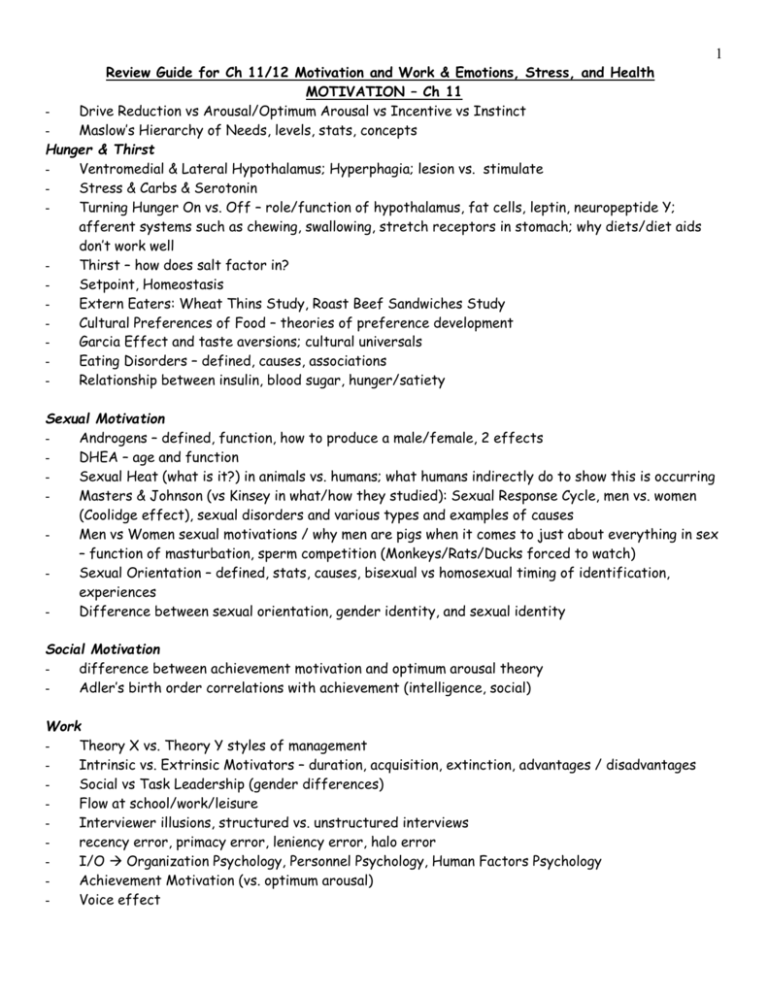
1 Review Guide for Ch 11/12 Motivation and Work & Emotions, Stress, and Health MOTIVATION – Ch 11 Drive Reduction vs Arousal/Optimum Arousal vs Incentive vs Instinct Maslow’s Hierarchy of Needs, levels, stats, concepts Hunger & Thirst Ventromedial & Lateral Hypothalamus; Hyperphagia; lesion vs. stimulate Stress & Carbs & Serotonin Turning Hunger On vs. Off – role/function of hypothalamus, fat cells, leptin, neuropeptide Y; afferent systems such as chewing, swallowing, stretch receptors in stomach; why diets/diet aids don’t work well Thirst – how does salt factor in? Setpoint, Homeostasis Extern Eaters: Wheat Thins Study, Roast Beef Sandwiches Study Cultural Preferences of Food – theories of preference development Garcia Effect and taste aversions; cultural universals Eating Disorders – defined, causes, associations Relationship between insulin, blood sugar, hunger/satiety Sexual Motivation Androgens – defined, function, how to produce a male/female, 2 effects DHEA – age and function Sexual Heat (what is it?) in animals vs. humans; what humans indirectly do to show this is occurring Masters & Johnson (vs Kinsey in what/how they studied): Sexual Response Cycle, men vs. women (Coolidge effect), sexual disorders and various types and examples of causes Men vs Women sexual motivations / why men are pigs when it comes to just about everything in sex – function of masturbation, sperm competition (Monkeys/Rats/Ducks forced to watch) Sexual Orientation – defined, stats, causes, bisexual vs homosexual timing of identification, experiences Difference between sexual orientation, gender identity, and sexual identity Social Motivation difference between achievement motivation and optimum arousal theory Adler’s birth order correlations with achievement (intelligence, social) Work Theory X vs. Theory Y styles of management Intrinsic vs. Extrinsic Motivators – duration, acquisition, extinction, advantages / disadvantages Social vs Task Leadership (gender differences) Flow at school/work/leisure Interviewer illusions, structured vs. unstructured interviews recency error, primacy error, leniency error, halo error I/O Organization Psychology, Personnel Psychology, Human Factors Psychology Achievement Motivation (vs. optimum arousal) Voice effect 2 - - - EMOTION, STRESS AND HEALTH – Ch 12 3 Components of an Emotion Support / Refute the stereotype that women are more expressive than men. According to recent research, what do we now know about how physiological responses can be measurably different? Put these terms in order for all emotion theories (when applicable): stimulus, emotion, cognition, physiological response Common Sense vs. James-Lange vs. Cannon Bard Theories: When does emotion occur relative to the physiological response? Which theory explains how simply mimicking facial expressions can cause us to actually feel the associated emotions? Schachter’s 2 Factor: How is the role of cognition different in this theory? Opponent Process Theory of Emotion Sympathetic vs. Parasympathetic: bodily responses, death (scared to death vs. voo-doo death) Yerkes-Dodson Law and implications What do lie detectors (polygraphs) actually measure? What is a better (more modern and recently developed) modification of the polygraph? What is brain fingerprinting? Fear Amygdala damage vs. Hippocampus damage; amygdala’s role (especially in automatic responses prior to cognition Zajonc’s theory) Anger When is the cathartic method helpful? What are its dangers? How does negative reinforcement relate? Examples of mixed results of catharsis? Reconciliation vs. retaliation Happiness How can the feel-good-do-good phenomenon encourage us to do nice things? difference between relative deprivation principle and adaptation-level phenomenon; what isn’t happiness? Lazarus’s Cognitive-Mediational Theory S.M.’s condition…what could she what couldn’t she do? Universality of facial expressions (babies!) Ohman and Stockholm: research on facial detection conclusion? Ekman’s Facial Feedback theory: smile if you want to be happy! Stress and Health The 2 stress hormone systems; cortisol; effect of stress on susceptibility to various diseases/illness in general Selye’s General Adaptation Syndrome (GAS) Type A vs. Type B Personalities and health effects (link to heart disease) What is a psychophysiological illness? Function of white blood cells: T vs. B lymphocytes Perceived control and the effect of stress (know the rat experiment described in Fig 12.30) Predictors of mortality (Fig 12.34), Effect of Religion on health (Fig 12.35/36) Leading cause of death in the U.S. today


